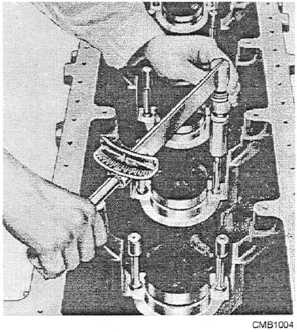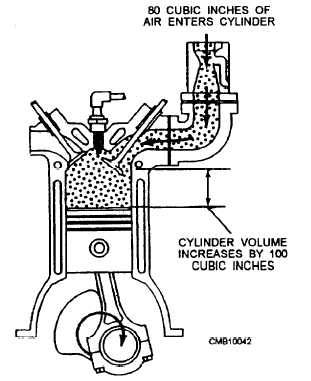force being applied from a wrench that is l-foot long. When a 2-foot-long wrench is used, only a 50-pound force is required. An illustration of a torque wrench in use is shown in figure 2-21.
DO NOT confuse torque with work or with power. Both work and power indicate motion, but torque does not. It is merely a turning effort the engine applies to the wheels through gears and shafts.
ENGINE TORQUE is a rating of the turning force at the engine crankshaft. When combustion pressure pushes the piston down, a strong rotating force is applied to the crankshaft. This turning force is sent to the transmission or transaxle, drive line or drive lines, and drive wheels, moving the vehicle. Engine torque specifications are provided in a shop manual for a particular vehicle. One example, 78 pound-feet @ 3,000 (at 3,000) rpm is given for one particular engine. This engine is capable of producing 78 pound-feet of torque when operating at 3,000 revolutions per minute.
FRICTION is the resistance to motion between two objects in contact with each other. The reason a sled does not slide on bare earth is because of friction It slides on snow because snow offers little resistance, while the bare earth offers a great deal of resistance.
Friction is both desirable and undesirable in an automobile or any other vehicle. Friction in an engine is undesirable because it decreases the power output; in other words, it dissipates some of the energy the engine 2-16

Figure 2-21. - Torque wrench in use, tightening main bearing stud of an engine.
produces. This is overcome by using oil, so moving components in the engine slide or roll over each other smoothly. Frictional horsepower (fhp) is the power needed to overcome engine friction. It is a measure of resistance to movement between engine parts. Frictional horsepower is POWER LOST to friction. It reduces the amount of power left to propel a vehicle. Friction, however, is desirable in clutches and brakes, since friction is exactly what is needed for them to perform their function properly.
One other term you often encounter is INERTIA. Inertia is a characteristic of all material objects. It causes them to resist change in speed or direction of travel. A motionless object tends to remain at rest, and a moving object tends to keep moving at the same speed and in the same direction. A good example of inertia is the tendency of your automobile to keep moving even after you have removed your foot from the accelerator. You apply the brake to overcome the inertia of the automobile or its tendency to keep moving.
The term efficiency means the relationship between the actual and theoretical power output. Volumetric efficiency (fig. 2-22) is the ratio between the amount of air-fuel mixture that actually enters the cylinder and the amount that could enter under ideal conditions. The greater volumetric efficiency, the greater the amount of air-fuel mixture entering the cylinder; and the greater

Figure 2-22. - Demonstrating volumetric efficiency.
Continue Reading